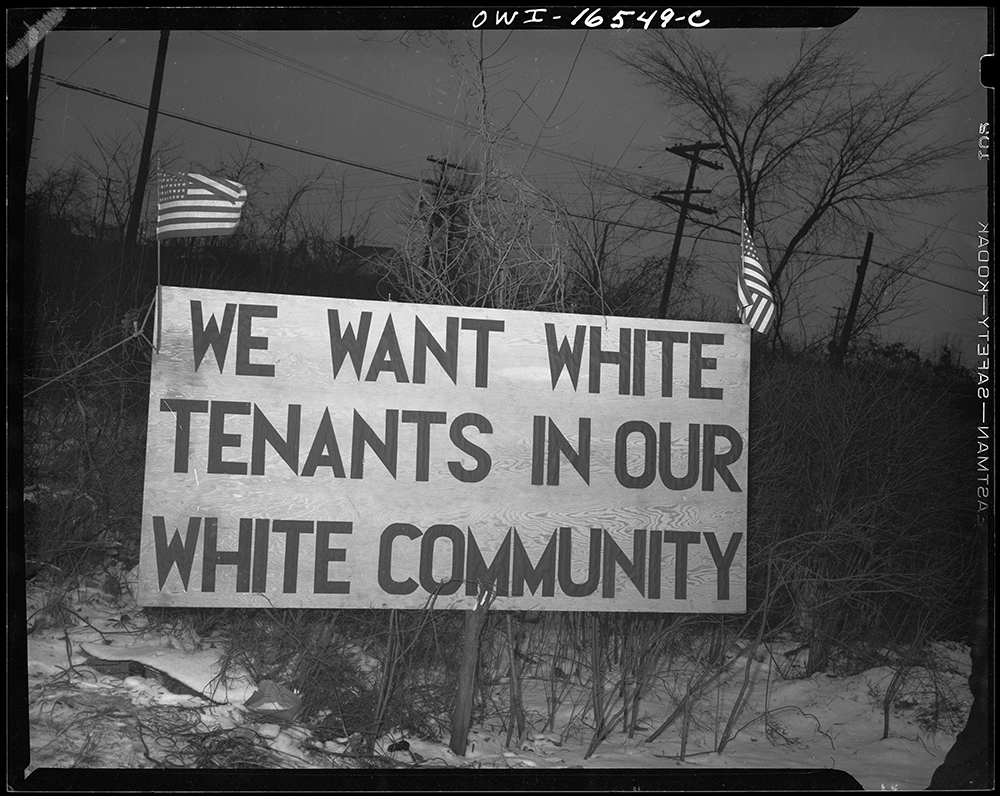Our House Divided: What U.S. Schools Don’t Teach About U.S.-Style Apartheid
Reading by Richard Rothstein
In 1942, white neighbors of the Sojourner Truth homes, a new federal housing project in Detroit, rioted in an attempt to prevent Black tenants from moving in. This sign was directly opposite the homes. Arthur S. Siegel, U.S. Farm Security Administration, Library of Congress 2017844754.
We have paid great attention to Nelson Mandela’s call for forgiveness and reconciliation between South Africa’s former white rulers and its exploited Black majority. But we have paid less attention to the condition that Mandela insisted must underlie reconciliation: truth. The Truth and Reconciliation Commission that Mandela established, and that Archbishop Desmond Tutu chaired, was designed to contribute to cleansing wounds of the country’s racist history by exposing it to a disinfecting bright light. As for those Afrikaners who committed even the worst acts of violence against Black people, they could be forgiven and move on only if they acknowledged the full details of their crimes.
In the December, 2013 School Administrator, I write that we do a much worse job of facing up to our racial history in the United States, leading us to make less progress than necessary in remedying racial inequality.
We have many celebrations of the Civil Rights Movement and its heroes, but we do very little to explain to young people why that movement was so necessary. Earlier this week, the New York Times described how the Alabama Historical Association has placed many commemorative markers around Montgomery to commemorate civil rights heroes like Martin Luther King Jr. and Rosa Parks, but declined — because of “the potential for controversy” — to call attention to the city’s slave markets and their role in the spread of slavery before the Civil War.
Throughout our nation, this fear of confronting the past makes it more difficult to address and remedy the ongoing existence of urban ghettos, the persistence of the Black-white achievement gap, and the continued underrepresentation of African Americans in higher education and better-paying jobs.
One of the worst examples of our historical blindness is the widespread belief that our continued residential racial segregation, North and South, is “de facto,” not the result of explicit government policy but instead the consequence of private prejudice, economic inequality, and personal choice to self-segregate.
But in truth, our major metropolitan areas were segregated by government action. The federal government purposefully placed public housing in high-poverty, racially isolated neighborhoods to concentrate the Black population, and with explicit racial intent, created a whites-only mortgage guarantee program to shift the white population from urban neighborhoods to exclusively white suburbs. The Internal Revenue Service granted tax-exemptions for charitable activity to organizations established for the purpose of enforcing neighborhood racial homogeneity. State-licensed realtors in virtually every state, and with the open support of state regulators, supported this federal policy by refusing to permit African Americans to buy or rent homes in predominantly white neighborhoods. Federal and state regulators sanctioned the refusal of the banking, thrift, and insurance industries to make loans to homeowners in other-race communities. Prosecutors and police sanctioned, and often encouraged, thousands of acts of violence against African Americans who attempted to move to neighborhoods that had not been designated for their race. ■

